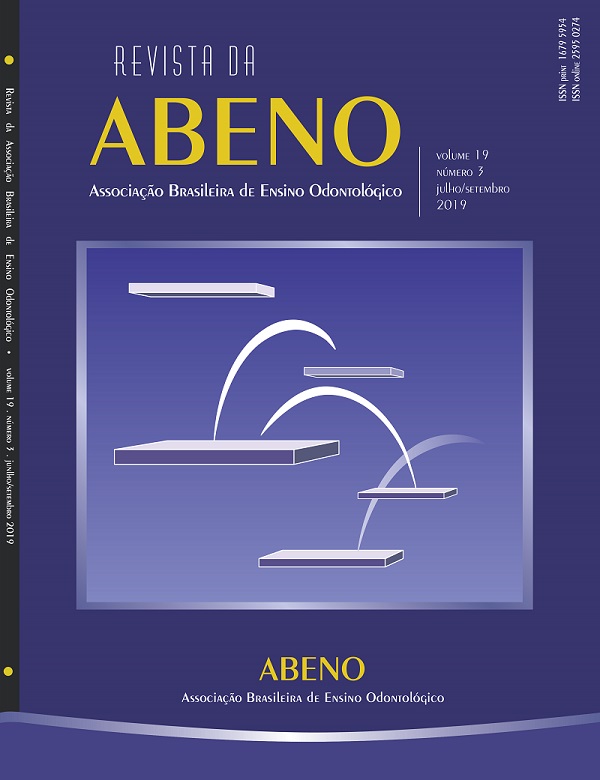Oral and maxillofacial anatomical structures acknowledgment through cone beam computed tomography images – a teaching practice experience
DOI:
https://doi.org/10.30979/rev.abeno.v19i3.903Keywords:
Education, Dental. Cone-Beam Computed Tomography. Radiology. Medical Informatics.Abstract
This study proposed to report a cone beam computed tomography (CBCT) teaching methodology applied to Dental School students by assessing mid-term and end-term exams correct recognition of anatomical structures. Students were instructed on oral and maxillofacial anatomical structures and clinical applications of CBCT imaging through lectures and hands-on classes, comprising forty-five hours of classes. They were submitted to two tests, the first one at mid-term and the second one at end-term. Anatomical structures recognition test scores (three variables: 1) name, 2) side – left/right and 3) multiplanar reconstructions (MPR) orthogonal images identification) were compared to verify if learning improvement occurred. Medians and Wilcoxon tests compared mid with end term exams. Median values for variable 1 were 6.0 (mid-term) and 8.0 (end-term). With regard to variable 2, median values ranged from 9.0 (mid-term) to 10.0 (end-term). When variable 3 results were analyzed, both mid-term and end-term medians were 10.0. Wilcoxon test (p<0.05) showed significant differences when comparing mid-term and end-term exams in each of the three categories. Linear correlations were established among the three categories. Correlations were statistically significant for two associations (“anatomical structure name” with “anatomical structure side”, and “anatomical structure name” with “MPR images”). Predoctoral dental school students presented a comprehensive improvement in terms of correctly recognizing anatomical structures name and side, as well as MPR images when comparing mid-term and end-term tests.
Downloads
References
Adibi S, Zhang W, Servos T, O’Neill PN. Cone beam computed tomography in dentistry: what dental educators and learners should know. J Dent Educ. 2012;76 (11):1437-42.
Scarfe WC, Farman AG, Sukovic P. Clinical applications of cone-beam computed tomography in dental practice. J Can Dent Assoc. 2006;72(1):75-80.
Cavalcanti MGP. Cone beam computed tomographic imaging: perspective, challenges, and the impact of near-trend future applications. J Craniofac Surg. 2012;23(1):279-82.
Whitesides LM, Aslam-Pervez N, Warburton G. Cone-beam computed tomography education and exposure in oral and maxillofacial surgery training programs in the United States. J Oral Maxillofac Surg. 2015;73(3):522-8.
Carter L, Farman AG, Geist J, Scarfe WC, Angelopoulos C, Nair MK, et al. American Academy of Oral and Maxillofacial Radiology executive opinion statement on performing and interpreting diagnostic cone beam computed tomography. Oral Surgery, Oral Med Oral Pathol Oral Radiol Endodontology. 2008;106(4):561-2.
Kobayashi-Velasco S, Salineiro FCS, Gialain IO, Cavalcanti MGP. Diagnosis of alveolar and root fractures: an in vitro study comparing CBCT imaging with periapical radiographs. J Appl Oral Sci. 2017; 25(2): 227-33.
Parashar V, Whaites E, Monsour P, Chaudhry J, Geist JR. Cone beam computed tomography in dental education: a survey of US, UK, and Australian dental schools. J Dent Educ. 2012;76(11):1443-7. A
Murakami T, Tajika Y, Ueno H, Awata S, Hirasawa S, Sugimoto M, et al. An integrated teaching method of gross anatomy and computed tomography radiology. Anat Sci Educ. 2014;7(6):438-49.
Shah P, Venkatesh R. Dental students’ knowledge and attitude towards cone-beam computed tomography: an Indian scenario. Indian J Dent Res. 2016;27(6):581-5.
Kamburoglu K, Kursun S, Akarslan ZZ. Dental students’ knowledge and attitudes towards cone beam computed tomography in Turkey. Dentomaxillofacial Radiol. 2011;40(7):439-43.
Slanetz PJ, Kung J, Eisenberg RL. Teaching radiology in the millennial era. Acad Radiol. 2013;20(3):387-9.
Machado JAD, Barbosa JMP, Ferreira MAD. Student perspectives of imaging anatomy in undergraduate medical education. Anat Sci Educ. 2013;6(3):163-9.
Lufler RS, Zumwalt AC, Romney CA, Hoagland TM. Incorporating radiology into medical gross anatomy: does the use of cadaver CT scans improve students’ academic performance in anatomy? Anat Sci Educ. 2010;3(2):56-63.
Cui D, Wilson TD, Rockhold RW, Lehman MN, Lynch JC. Evaluation of the effectiveness of 3D vascular stereoscopic models in anatomy instruction for first year medical students. Anat Sci Educ. 2017;10(1):34-45.
Ravesloot CJ, Van Der Schaaf MF, Van Schaik JPJ, Ten Cate OTJ, Van Der Gijp A, Mol CP, et al. Volumetric CT-images improve testing of radiological image interpretation skills. Eur J Radiol. 2015;84(5):856-61.
Torres A, Staśkiewicz GJ, Lisiecka J, Pietrzyk Ł, Czekajlo M, Arancibia CU, et al. Bridging the gap between basic and clinical sciences: A description of a radiological anatomy course. Anat Sci Educ. 2016;9(3):295-303.
Al-Rawi W, Jacobs R, Hassan B, Sanderink G, Scarfe W. Evaluation of web-based instruction for anatomical interpretation in maxillofacial cone beam computed tomography. Dentomaxillofacial Radiol. 2007;36(8):459-64.
Downloads
Published
How to Cite
Issue
Section
License
Autores que publicam nesta revista concordam com os seguintes termos:
a) Autores mantém os direitos autorais e concedem à revista o direito de primeira publicação, com o trabalho simultaneamente licenciado sob a Licença Creative Commons Attribution que permite o compartilhamento do trabalho com reconhecimento da autoria e publicação inicial nesta revista.
b) Autores têm autorização para assumir contratos adicionais separadamente, para distribuição não-exclusiva da versão do trabalho publicada nesta revista (ex.: publicar em repositório institucional ou como capítulo de livro), com reconhecimento de autoria e publicação inicial nesta revista.
c) Autores têm permissão e são estimulados a publicar e distribuir seu trabalho online (ex.: em repositórios institucionais ou na sua página pessoal) a qualquer ponto antes ou durante o processo editorial, já que isso pode gerar alterações produtivas, bem como aumentar o impacto e a citação do trabalho publicado (Veja O Efeito do Acesso Livre).






